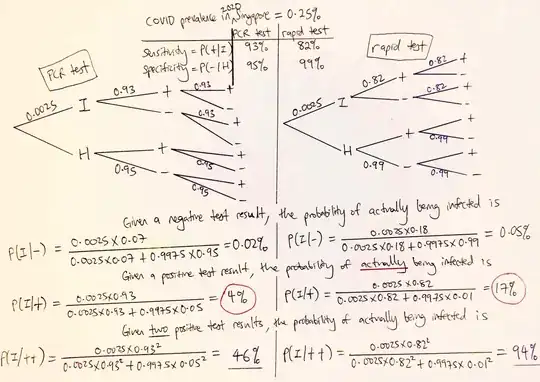The theory of probability, particularly the causal Bayesian probability is quite intriguing, and sometimes gets challenging. I have one such problem at hand which makes sense to me, but not able to decode the mechanics of its sample space, or let's say the probability tree that defines the way I can look back to the cause. So, here it goes.
Before testing for COVID, Jemima has a prior probability of 0.45 of having COVID. If Jemima has COVID, there is a probability of 0.9 that the test would come positive and a probability of 0.1 that the test would come out negative. If Jemima does not have COVID, there is a probability of 0.14 that the test would come positive and a probability of 0.86 that the test would come out negative. Multiple tests provide independent information. Jemima takes two tests. Both tests come out negative. What is the posterior odds-ratio that Jemima has COVID?
So far, I have been able to figure out the obviously easy information that Jemima gets a negative result is
P(Negative) = $0.45 \times0.1+0.55\times0.86=0.518$
and hence, the Bayesian probability on a single trial that Jemima actually has COVID is
P(COVID = T | Negative) = $0.45 \times0.1\over 0.518 $$\approx 0.087$
But where does that lead me further, w.r.t. Jemima getting a negative test twice in a row, has stumped me honestly. I did try thinking as if i should take the square of the above probability of 0.518, for the joint probability of such an outcome, given independent events. But then, what to keep in the numerator to justify the objective? Thoughts??
